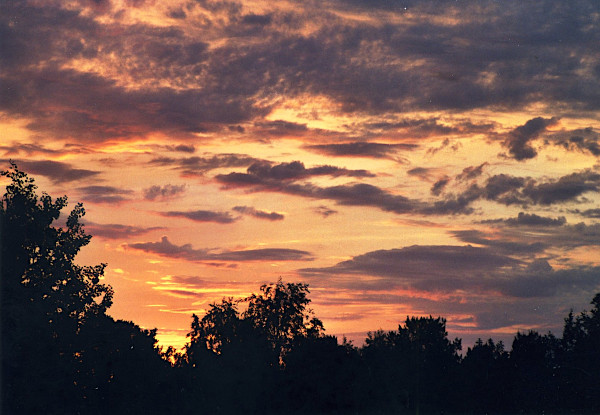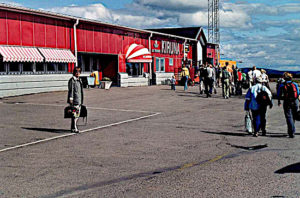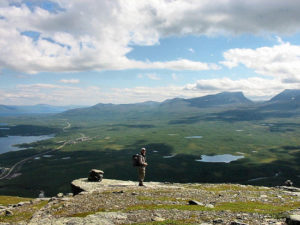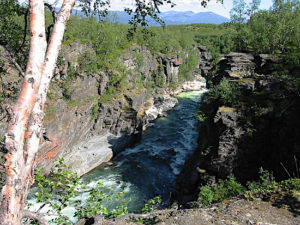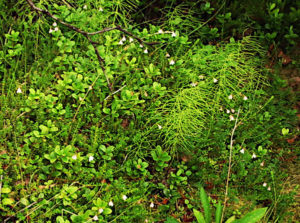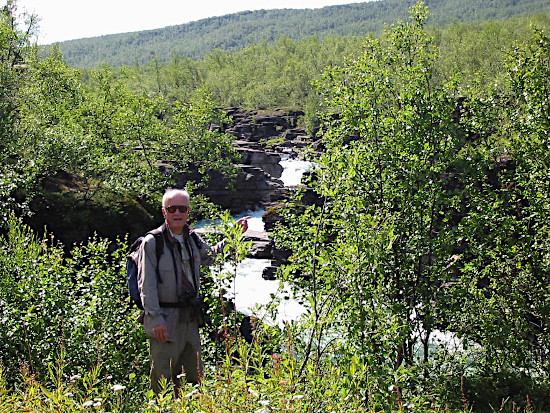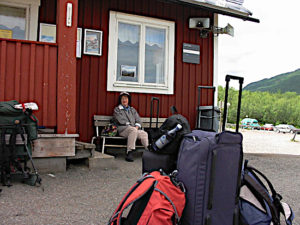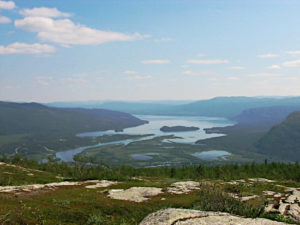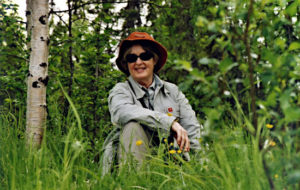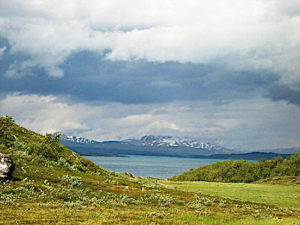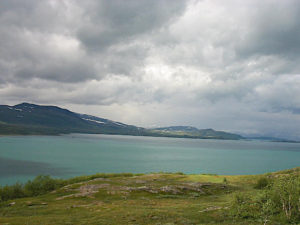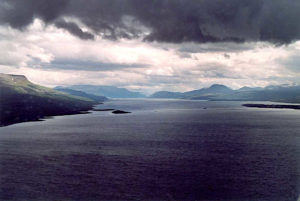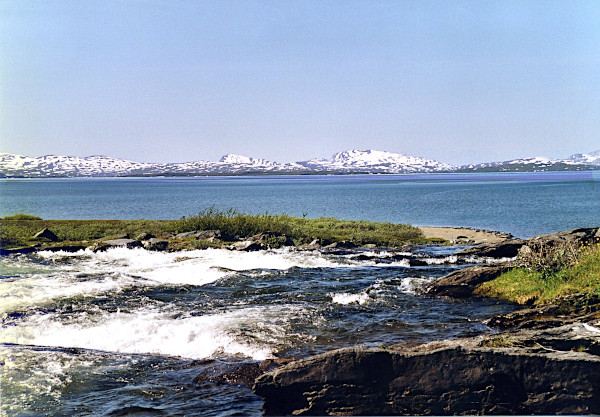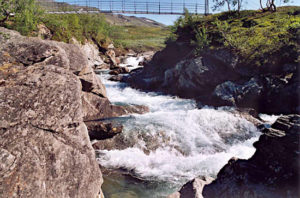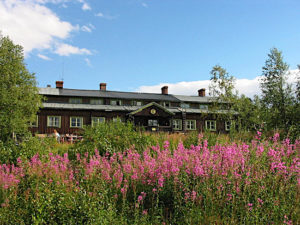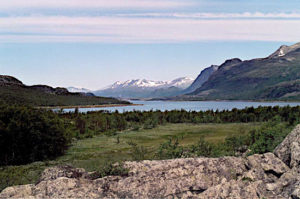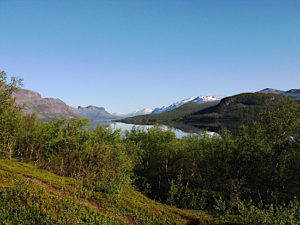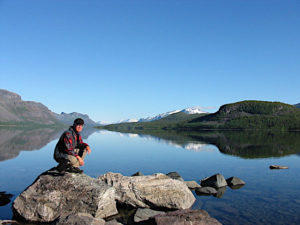Chapter 37 (Part 2) — Lapland revisited
Soon after the beginning of the new millennium we decided this was the time to revisit my old haunts in northern Lapland, far above the arctic circle, Abisko and Saltoluokta first, in 2002. In 2003 we came back to see as much as there remained of the wonderful places Mother, Gun and I had got to know in 1950.
John and I landed at Kiruna airport, possibly the cutest little airport in the world. We took a bus that was waiting outside direct to Abisko. The tourist station has completely changed, for one thing because of the fire that broke out not long after we had been there in 1947. It also needed bigger premises due to the increased popularity of mountain hiking in northern Lapland. A little red house tucked onto one of the new buildings is all that remains of the building the way it once was.
John and I spent a few very pleasant days in Abisko even though we did not particularly like the huge dining room where none of the charm was left from a past era.
We hiked some and of course we took the chairlift up on the little mountain Nuolja, which only Gun climbed, back in the days before chairlifts. I remember that she climbed up to see the midnight sun with Olle Lundquist and some other friends. Gun would always find a boyfriend wherever she was.
Back then, we were staying in a little hut called Annersia, which Arne figured out meant the other side — of the railroad, which at the time took us to Abisko and to Narvik and Lofoten. It had one room with four bunk-beds. We had all our meals at the tourist station dining room, which was in those days a cozy, not too big room with a big table in the center where everybody served themselves.
In 2002, things had changed — of course. Now we were staying in great but austere comfort in the main building, at least as far as I can remember. The dining room was like a mess hall with none of the charm of a past era.
We very much liked the ‘jokk’ (river), Abiskojokk of course, that made a sort of canyon where it got to the bridge we crossed on our hikes.
One day we followed Abiskojokk to the place where it runs into Torne Träsk, the big lake that is anything but a träsk (= marsh, bog). I found a gorgeous little patch of linnea (linnea borealisà) close to the end of the jokk. Since they are quite rare, I find, in the Abisko area, I
took a picture of the patch where they are quite close together and not so spread out that it is hard to get a good photo. Linnea seemed to be far more ubiquitous in the Saltaluokta region, all through the forests. Even in Stalo, if I remember right, there were plenty of linnea.
With Nuioja and Abiskojokk and a few hikes starting by crossing the bridge over the jokk we enjoyed Abisko, even though the tourist station had lost its homely charm.
We took the train from the very small station just across the road from Abisko tourist station. It took us to Jokkmokk, where we caught a bus which left us off towards the late afternoon on the north side of Lake Langas, to be shipped across the lake in a nice little boat to Saltoluokta tourist station, which of course did not look like anything I remembered from 1950. No surprise. The dining-room was loaded with good food, and the ambiance was very friendly. Nothing at all like the mess hall in Abisko. We felt as if we had come home.
We booked ourselves for a next-day guided hike to Hermelins fall (waterfall), and I was all too conscious of being the old-age person in the little group.
After a couple of more hikes, and a few very pleasant days in Salto, we took the bus from the northern side of the lake to a new tourist station up aside the lake. This is Ritsem, which is right across from the lake where Vaisaluokta Sami village had once fascinated us in 1950. The next day (in 2002) we took the helicopter to get to Staloluokta for the first time since 1950. More about Salto and Stalo below. It’s hard to keep 2002 and 2003 apart for those two “fjäll stations” since we went to bot places twice.
Now over to 2003 and Kvikkjokk, which had also been enlarged and modernized. We enjoyed the beautiful site right next to the wild-water jokk, Kamajokk, thousands of wonderful birches and globe flowers.
One of our first walks was to the top of Prinskullen, starting out with a boat ride to the foot of the little mountain on the northern side of Kamajokk delta. The view over Sarek National Park from the top of Prinskullen was still in 2003 grandiose with lots of snow on the Sarek fjäll.
The view from the very border of Sarek National Park gives a good idea of what Sarek is like — pristine high and partly snow-covered mountains and a complete wilderness. No huts, almost no tourists. The few tourists there are carry their own tents. The view, however, was still not equal to what we saw in 1950 when we also climbed Prinskullen to look into Sarek: A snow-covered wonderland. We still loved the view in 2003 very much, but it was sad to see the enormous destruction on the side of Prinskullen due to a tempest that had uprooted masses of trees that were now just lying on the ground across bushes and tree stubs, and across the path. Will anyone ever clear that up?
On another day we used the friendly boat service to take us to a little wooden dock from where we made a short but pleasant little walk to an old mill. As we were waiting for the boatman to come back and pick us up, John took a picture of me waiting.
In Kvikkjokk, no matter where you want to go from the lake, you first have to be taken by boat past the Kamajokk delta to the south or north shore of Lake Sangat.
ngg_shortcode_0_placeholder
In 2003, we took the helicopter to get from Kvikkjokk to Staloluokta, gorgeously situated on lake Virihaure. We liked it so much the year before that we (especially I) wanted to go back. We now knew the completely changed look of this little tourist station. There was a house with small bunk-equipped bed rooms and a big eating or common-room. A small but very satisfactory kitchen where people cooked light meals. They also sometimes left an assortment of non-spoiling eating products in a cabinet above the sink. In Stalo you had to have your own food provisions, unless you wanted to depend on the over-smoked trout that was sold in a stand run by a woman. As I remember she did not sell anything but smoked trout.
There was a pump that sometimes worked in the back of the house which you passed by on your way to the outhouse. In 2003 the pump was out of order and the men had to carry in buckets of water they fetched from the jokk very close by. Water is wonderfully clean in Samiland.
And it is cold — as we found out when we took a dip after our walk up along the northern side of Viejejokk in 2003.
We said ‘Hej’ to the other guests in the house after our arrival. And we very happily got installed in our little room with two bunk beds. We were going to spend a couple of days in the paradise of my youth. It was different from sleeping in a hut in 1950 with the only available water coming from a small tube tucked in between rocks and delivering water from melting snow. There was less snow now on the Norwegian mountains, but there was going to be even less.
On our first visit to Stalo in 2002 we one day walked up north on Padjelantaleden. The lake on our left was beautiful and the scenery all around us. After a while we had to turn back since we were leaving by helicopter that very day, after a little lunch in the eating room.
The sky was changing as we had turned around and dark grey clouds were amassing in the west, which changed the colors of lake Virihaure.
The surface now became a gorgeous and shifting leaden green. We were dressed in our Gortex jackets and fast-drying pants and we were little worried, mainly feeling the drama of the sky and water on our right now.
The cloudburst came on fast and the entire landscape changed dramatically. The dark grey clouds and the lead grey lake made a scene worthy of Kaspar David Friedrich, our friend Tillman Kaiser’s favorite painter. (I see that Tillman has changed completely though since we bought a painting from him, which we like a lot.)
At the Stalo tourist station, since there was no host, everybody had to do his share of the cleaning before leaving. This time I can’t remember what our share was, but we naturally swept out our own little room. The following year though I clearly remember, since we were the last ones to leave, wiping off all the very long tables in the eating room, about five of them, or six maybe. And I seem to remember seeing someone else sweeping the floor. John of course brought up a bucket of water from the jokk, since the pump was out of order. That time, in 2003 I know we bought some smoked trout since we had nothing else to eat. It was not very good.
On our second visit to Stalo we one day chose to take a walk along the jokk, Vieijejokk, that flows into Virihaure right close to the tourist house. This was not the path we took in 1950 to get back to Kvikkjokk, walking first to Tarraluoppal in the magic Tarradaled ( dal = valley). Back then, we started out by crossing the bridge that is right close to the place where Viejejokk runs out into Virihaure.
We followed the jokk as far as to a bridge where two paths separated and which was a beautiful place to have lunch. I went down right next to the water and found very soon that the mosquitos were eating me up, especially around the ankles.
We did not linger among the mosquitos but turned around pretty soon. The jokk was gorgeous, but definitely not for shooting down the rapids. When we got back to the house, we had the fun idea of taking a dip in the jokk — to replace a shower. It was fun but a bit chilly.

We are getting back close to Virihaure and John’s silhouette is seen against the Norwegian mountains.
We took the helicopter back to Kvikkjokk for one night, and the next day caught a bus to Jokkmokk. Jokkmokk is a nice little town, but we did not linger. From there we arrived one afternoon in Saltoluokta.
We got off the bus on the north side of Lake Langas and took the boat with all the other tourists across to the tourist station which is up a long and gentle hill. We always travel with too much luggage. We were not backpacking the way my family had done in 1950, and we were bound for one more of my unforgettable paradise places after Salto, which was to be Staloluokta.
Now, dragging our carry-ons up the long hill, we were suddenly met with a forest of one of my favorite flowers — mjölke, which has a much more poetic name in German and English, Heidenröslein is so pretty (even though it is not a rose of any kind) and so is willowherb.
That tourist station too had completely changed, of course, since 1950. At that time we were very happy to get to a tourist station with kitchen facilities. Now there is a large building as the center and at least two more buildings behind and on the side. One for backpackers who don’t feel like spending money on cooked meals and one for us effete snobs who want a comfortable room and delicious cooked meals served on the long table in the middle of the dining-room. John and I even had a room with a shower in Laponia, as the building in the back was named. Times do change, and I think it is safe to say that we are getting more and more spoiled.
We got to know a young Dutch couple (who spoke Swedish fluently and without a foreign accent, but English with us). They actually walked back and forth to Sitojaure, where the hut looks out on the gorgeous lake, the lake a man took us across in a rowboat many eons ago. It is of course a motorboat today. But our Dutch friends must have done 40 km at least in one day. That beats the 35 km Mother, Gun and I did on the next to last stretch from Stalo to Kvikkjokk. The very last stretch was short, but those last two days we survived on cloud-berries and pinnbröd (bread, if it can be called that), held on a stick over an open fire. We clearly had flour, salt and matches. Matches does not surprise me. But salt and flour seems quite unbelievable .
In 2003 after our second stay in Saltoluokta and after a couple of pleasant hikes west and south, we were prepared to leave by boat and bus to travel homewards. We got up early in the morning and went down to the lake which was like a glass mirror in the windless world. The mirror stretched as far as to the point where the snowy mountains come all the way down to the water. I will remember that.
Continued: Chapter 38 —Sweden, Jews and Nazi Germany
